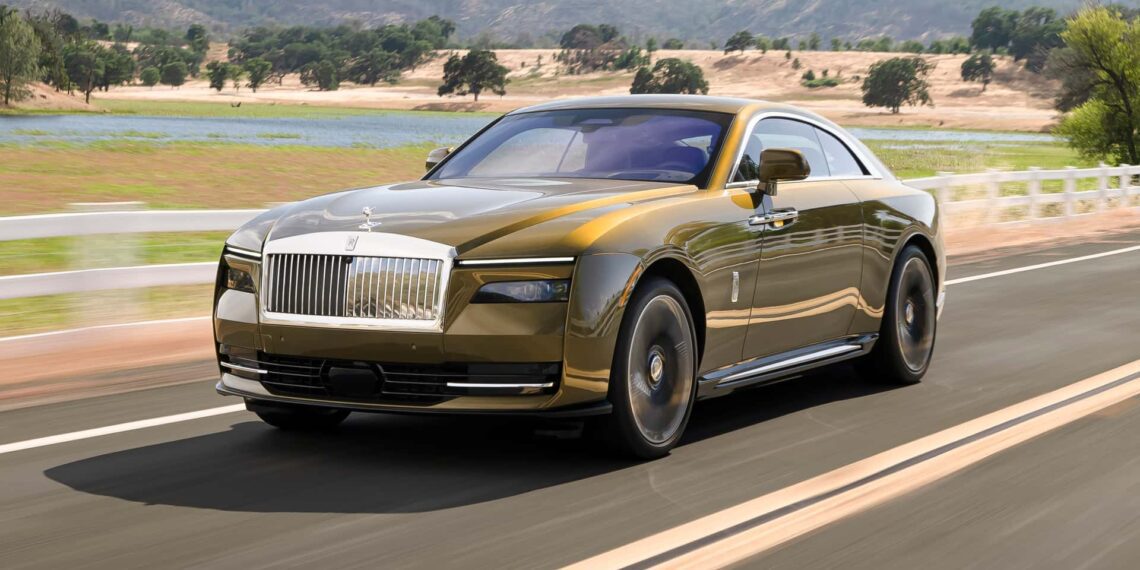Rolls-Royce has spent billions developing a range of vehicles as comfortable, quiet, and opulent as a car can be. However, regardless of how much sound deadening you throw at an internal combustion engine, it will always produce a sound, even if just a low-distant rumble.
The next logical step in search of a genuinely silent driving experience would be to ditch the ICE entirely in favor of electric motors and batteries, precisely what the 2024 Rolls-Royce Spectre does. But, whereas other carmakers seek electric power primarily for its environmental benefits, the Spectre leans on its new powertrain to reach its core goals.
I flew to the Nappa Valley to drive the British carmaker’s first EV, which read like another big cushy cruiser on paper. However, with over 375 pounds of sound deadening aided by a 1,543-lb battery pack further dampening road noise and road imperfections, the Spectre achieves true silence. Whether on smooth roads or rough asphalt, nothing disrupts the driving experience, reaching a level of isolation so mute it’s startling.
If a Rolls Royce’s goal is complete seclusion from the world around you, then the Spectre may be the best ever.

Quick Stats
| Motor | Two Separately Excited Synchronous Motors |
| Output | 584 Horsepower / 664 Pound-Feet |
| Battery | 102 Kilowatt-Hours Lithium-Ion |
| EV Range | 260 Miles (EPA Estimate) |
| Weight | 6,371 Pounds |
| Base Price | $420,000 |
During its development, the Spectre covered more than 1.5 million miles simulating over 400 years of real-world use. The carmaker’s guiding principle was that the Spectre should be “a Rolls-Royce first and an electric car second.” A philosophy that’s immediately visible, whether from a design, tech, or powertrain perspective.
The most significant change surrounding the Spectre is that it’s an electric car, but you’d be hard-pressed to tell just by looking at it. Rather than leaning into a more sleek and futuristic aesthetic, Rolls-Royce chose to stick to the tall upright proportions that give their product line its distinct appearance, even retaining its long hood despite the lack of a big engine beneath it.
The Spectre is positioned as a spiritual successor to the Phantom Coupe, which tracks given that it’s as big as the car it’s inspired by but adds elements of newer models like the Wraith with its sloping fastback roofline.

The Spectre is an example of how multiple minor updates create a car that looks distinctly new but familiar. Take its updated Pantheon grille, the widest ever fitted to a Rolls, whose vanes have been angled to better channel air around the car’s front end, or its twin tail lights, now clear with just two vertical LED strips. The redesigned Spirit of Ecstacy sits up front with updated wings and a slimmer profile. This piece alone required over 830 hours of wind-tunnel testing to develop.
Although the Spectre doesn’t represent a considerable style departure from its predecessors, it works for me. Thanks to its size, it has plenty of presence, but with its sloping roofline and slimmer lighting elements, it’s both elegant and instantly recognizable as a Rolls-Royce.

The Spectre counts on two separately excited synchronous motors, one in each axle, making it all-wheel drive. Combined, the pair produce 584 horsepower and 664 pound-feet of torque, with most of the power coming from the rear. For context, this is more than the 563-hp you get in a Phantom or Ghost but slightly below the Black Badge Ghost’s 592-hp output.
The biggest differentiator is the Spectre’s curb weight figure, which, thanks to the 1,543-lb battery pack, is now a hefty 6,371 lb, or 617 lb more than a Phantom. The carmaker combats the weight gain by distributing the weight of the batteries evenly through the car’s floor while keeping its center of gravity low. The Spectre rides like a big and heavy thing, but then again, so does every other Rolls-Royce. It’s part of the appeal.

Contrary to what you’d expect from an EV, the Spectre doesn’t hand over all its power the instant you press the right pedal. Instead, it’s tuned to prioritize smoothness, only delivering a good grunt once you lean into it. Even its regenerative braking mode, which allows for single-pedal driving, prioritizes a seamless stop. All this amounts to a car that doesn’t like being driven aggressively. It’s still quick, reaching 60 mph in 4.4 seconds, but the Spectre would rather waft along than pounce.
Its slow steering rack shares the same philosophy, communicating no road imperfections requiring little effort to turn. It’s like trying to steer underwater. Even harsh inputs are softened. Its brakes are no different, with plenty of pedal travel. They come on progressively, again prioritizing smoothness while retaining enough bite to keep this 6,371-lb EV in check.
These dampening efforts help serve the Spectre’s two most significant components: its extensive sound deadening and active air suspension system. All Rolls-Royce’s are comfortable and near silent. That’s expected. But the Spectre takes things further with a totally isolating driving experience.

When I say that the Spectre is totally silent, it’s not hyperbole. On smooth roads like those in the Napa Valley, nothing intrudes the cabin. Not road imperfections, wind, or even the sound of passing cars. It’s so mute that I began hearing the tinnitus in my ears. Even on rougher roads, only the faintest road noise comes through. This is the main benefit of its electric powertrain. Turns out, the only way to improve on the brand’s outgoing V12 is with silent power.
The other contributors to the Spectre’s isolation are its suspension system and chassis, which combine 30 percent stiffer torsional rigidity, an active air damper system, active anti-roll bars, and an abundance of sensors constantly adjusting the car to best suit the road. The result is a car that glides regardless of the road quality. Combined with the lack of noise, how disconnected you feel from the asphalt beneath you is startling. It’s as close to sailing as driving can get.
Only when I encountered a winding road did the Spectre’s heft become apparent. Although its anti-roll bars try to keep the body in check, there’s no disguising its mass. It leans and responds slowly to inputs while its single-pedal driving mode slows aggressively at higher speeds. Like with its power delivery, the Spectre isn’t eager to hustle.

A twisty road isn’t exactly the Spectre’s home turf. Instead, it’ll mostly stick to city streets and open highways, where its electric powertrain shines. According to Rolls-Royce, most owners only travel around 30 miles per day. When surveyed about charging habits, almost all buyers signaled that they’d charge at home or their office, completely circumventing the U.S.’ troubled network.
Given these findings and its most likely use case, the Spectre’s comparatively low 260-mile EPA estimated range figure makes sense. Although on paper, it’s significantly less than what you’d get from a Lucid Air or even the BMW i7, plenty of the folks at the drive event mentioned seeing closer to 300 miles of range in the real world, although I’ll have to verify that with a follow-up test.
Its lithium-ion battery pack has a net capacity of 102 kilowatt-hours and can charge from 10 to 80 percent in 34 minutes at 195 kilowatts, about on par with most large EVs.

When stepping in, the first detail that strikes you is how big its doors are. They’re the largest ever fitted to a Rolls-Royce and house its latest lighting feature, starlight doors. They’re a play on the brand’s well-known starlight roof, adding 4,796 stars to the interior’s lower section. The illuminated Spectre nameplate on the dashboard adds a further 5,500 stars, allowing the cabin to fully come to life once the sun sets.
Although much of the Spectre’s switchgear is carried over from other Rolls-Royce models, this four-seat, two-door fastback adds a new digital instrument cluster, complete with a new set of graphics that can be customized to reflect the car’s configuration.

Despite its sloping roofline, the Spectre is a proper four-seater with plenty of head and legroom for the second row. However, given its fastback proportions, the Spectre is meant to be driven, especially as the U.S. is its biggest market, where chauffeurs are rarely used. This aligns with its range figures and estimated use case, as it will most likely serve as a commuter rather than a family hauler.

The Spectre starts at $420,000, just below the $460,000 Phantom. Once loaded with optional extras, the brand’s first EV can easily fall between $500,000-$600,000 when it arrives towards the end of this year. According to Rolls-Royce, the first two years of production are already sold out, with current delivery times estimated to be sometime in 2025.
The Spectre may be the brand’s first electric car, but the idea of a silent and potent powertrain fits Rolls-Royce’s mission perfectly. It represents the logical next step for a marque that over-engineers all its models to be as quiet and comfortable as possible. The fact that the Spectre is electric isn’t the big story. What matters is how this new technology pushes this fastback into a realm of its own, setting a new luxury benchmark in the process.
Add in its sleek good looks, ample cabin space, and focus on improving the finer details, and the Spectre is without question the best luxury car I’ve ever driven. As much as I’ve applauded the brand’s silky V12 in previous stories, I don’t miss it. Rolls-Royce plans to go fully electric by 2030, so the Spectre, even as good as it is, is only the beginning.






















